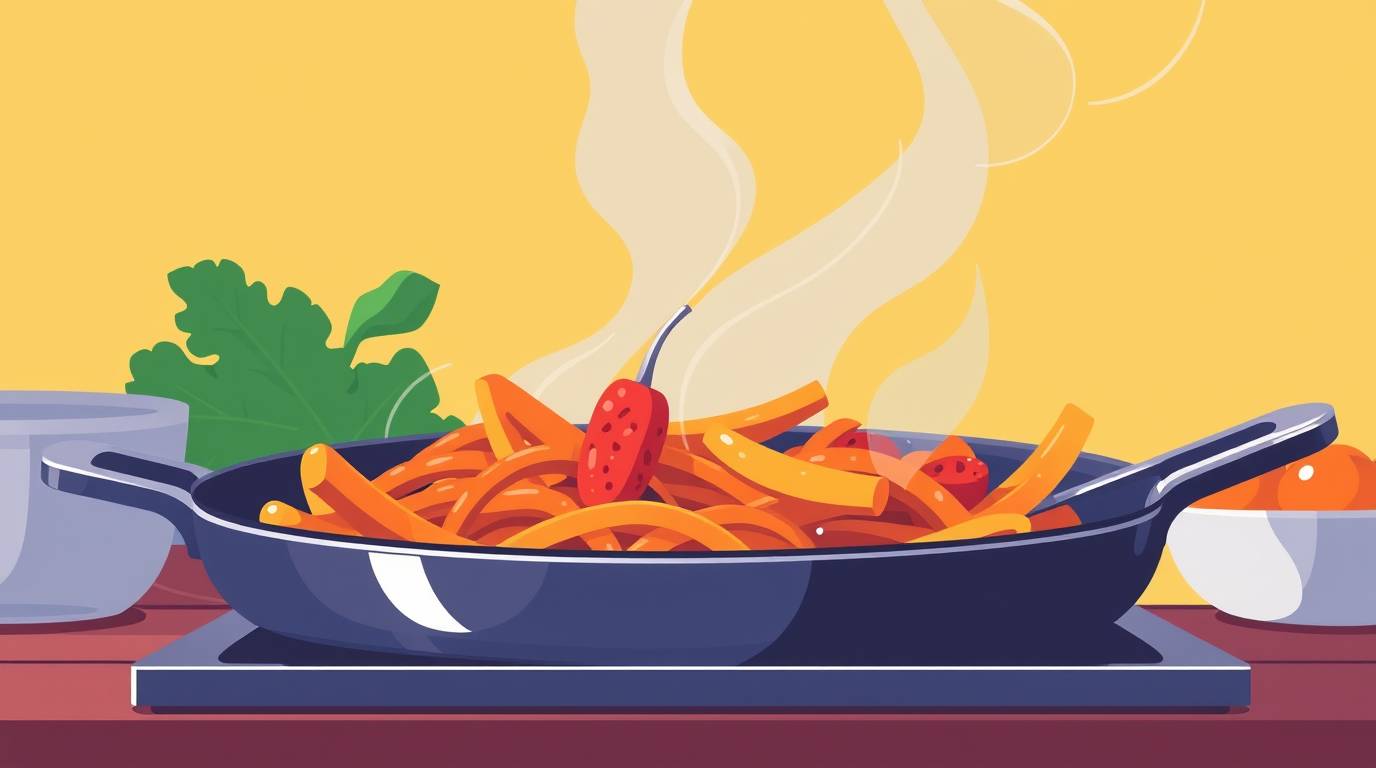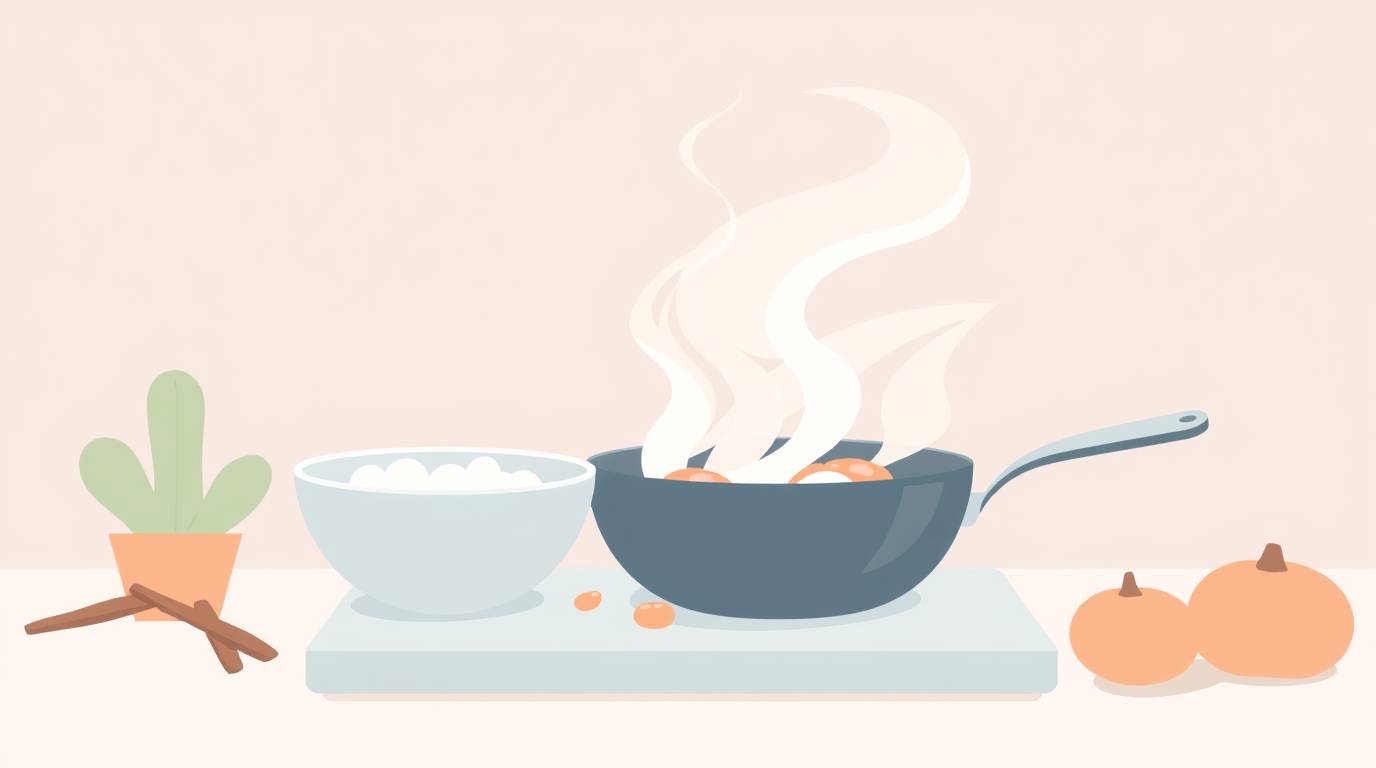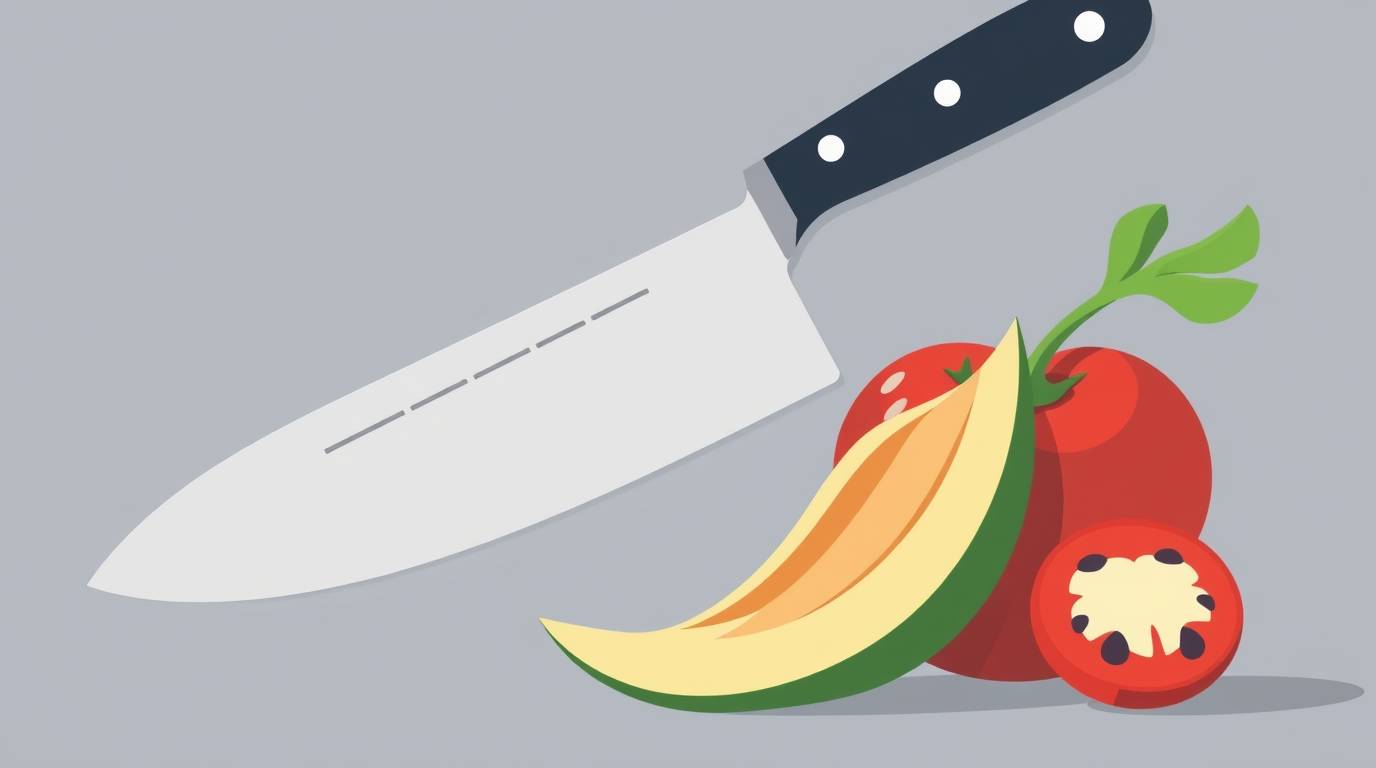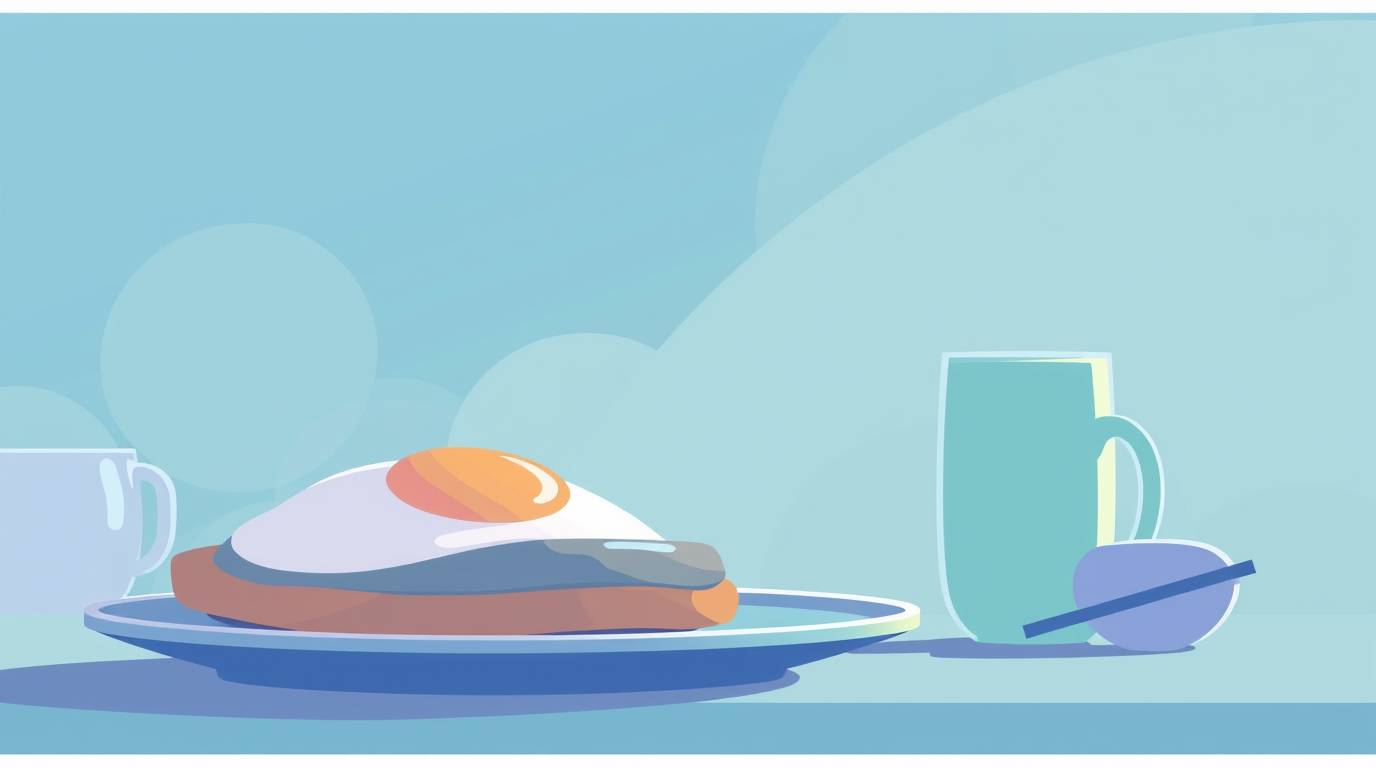At Flavoreer, we believe that every meal can be a source of joy, both visual and culinary. Our recipe generator, presentation guides, and community support are designed to help you find the perfect balance between appearance and practicality in your everyday cooking.
Table of Contents
Introduction: Why Presentation Matters
You've likely heard the saying "we eat with our eyes first." It's more than just a clever phrase—it's a scientific fact. Before your taste buds get a chance to experience a meal, your eyes have already made a judgment about how delicious it will be. That initial visual assessment sets expectations and can significantly impact how you perceive flavor.
But beautiful food presentation isn't just about impressing guests or taking pretty pictures for social media. There's a deeper value to taking a few extra moments to present your food thoughtfully:
- It shows respect for the ingredients and the effort you've put into cooking
- It enhances your everyday dining experience, making regular meals feel special
- It can make healthy foods more appealing (especially to picky eaters)
- It creates moments of mindfulness and appreciation in our rushed lives
- It transforms eating from mere sustenance into a full sensory experience
The good news? You don't need to be a professional chef to create visually appealing food. You don't need fancy equipment, artistic talent, or hours of extra time. With just a few simple techniques and a bit of awareness, you can elevate the look of your everyday meals from ordinary to special.
In this guide, we'll explore practical, accessible ways to improve your food presentation at home. Whether you're cooking a quick weeknight dinner for your family or preparing a special meal for guests, these tips will help you plate food that looks as good as it tastes—without adding stress or complexity to your cooking process.
Ready to transform your meals from merely delicious to visually stunning? Let's begin!
The Psychology of Food Presentation
Understanding how visual presentation affects our perception of food can help you make more intentional plating decisions.
How Appearance Influences Taste Perception
Research shows that beautifully presented food actually tastes better to most people:
Expectation setting:
- Attractive food creates higher expectations for flavor
- These expectations often lead to a more positive taste experience
- Our brains are primed to enjoy food that looks appealing
Value perception:
- Well-presented food is perceived as being worth more
- Diners report higher satisfaction with attractively plated dishes
- People are willing to pay significantly more for identical food that's better presented
Psychological impact:
- Visually appealing food activates reward centers in the brain
- Taking time to plate thoughtfully creates a moment of mindfulness
- Beautiful presentation demonstrates care and respect for both food and diner
Cultural Influences on Food Presentation
Different cultures prioritize various aspects of presentation:
Japanese aesthetics:
- Emphasis on negative space (ma)
- Seasonal references
- Natural, asymmetrical arrangements
- Individual serving vessels for different components
French approach:
- Precision and technique
- Structured arrangements
- Sauce as a visual element
- Emphasis on height and architecture
Nordic style:
- Minimalism and restraint
- Foraged elements
- Natural colors and textures
- Wildness and naturalism
Contemporary fusion:
- Combining techniques across traditions
- Unexpected color combinations
- Interactive elements
- Emphasis on provoking emotion
The Science of Visual Appetite
Specific visual elements trigger our desire to eat:
Color vibrancy:
- Bright, clear colors suggest freshness and nutrients
- Muted or gray tones can suppress appetite
- Natural food colors are more appealing than artificial ones
Contrast and variety:
- Visual variety suggests nutritional variety
- Contrasting colors create visual interest
- Different textures imply a more complex eating experience
Recognition and novelty balance:
- Food should be recognizable enough to be trusted
- Yet novel enough to create interest
- The sweet spot: familiar ingredients presented in fresh ways
Basic Plating Principles Anyone Can Master
You don't need formal culinary training to plate food beautifully. These fundamental principles will help you create visually appealing presentations every time.
The Rule of Thirds
This classic design principle works wonderfully for food plating:
Basic application:
- Mentally divide your plate into a 3×3 grid
- Place key components at intersection points of these lines
- Avoid centering everything in the middle of the plate
- Create deliberate focal points rather than scattered arrangements
Practical examples:
- Position protein at one intersection point
- Place a colorful vegetable at another intersection
- Leave some areas of the plate empty
- Use sauce to connect elements
Clock-Face Plating Method
A simple technique for balanced arrangement:
Basic method:
- Imagine your plate as a clock face
- Main protein at 6 o'clock position (nearest to diner)
- Starch at 10 o'clock position
- Vegetables at 2 o'clock position
- Garnish at 12 o'clock position
Variations:
- For family-style: arrange shared plates in clock positions around the table
- For multiple sauces: place at 4 and 8 o'clock positions
- For multi-course meals: keep consistent positions across courses
Odd Numbers Rule
Odd numbers of elements create more dynamic, interesting arrangements:
Application:
- Serve 3 or 5 scallops rather than 4
- Create groups of 3 for smaller items
- Use 3 different heights on the plate
- Place 3 sauce dots rather than 2 or 4
Why it works:
- Prevents too-perfect symmetry
- Creates natural visual movement
- Appears more spontaneous and artistic
- Makes counting less obvious
White Space (Negative Space)
Empty areas on the plate enhance the visual impact of the food:
Practical applications:
- Use larger plates for upscale presentation
- Leave some areas of the plate completely empty
- Avoid crowding components together
- Create breathing room between elements
Common mistakes to avoid:
- Filling every inch of the plate
- Portions too large for the plate
- Sauce covering the entire plate
- Too many garnishes cluttering the presentation
For step-by-step plating tutorials with visual examples, visit our basic plating techniques gallery.
Essential Tools for Beautiful Presentation
The right tools make food presentation easier and more professional—and many are already in your kitchen.
Must-Have Plating Tools
These affordable basics will instantly improve your presentation:
Offset spatula:
- Perfect for creating smooth sauce swooshes
- Helps place delicate items precisely
- Ideal for lifting thin slices without breaking
- Useful for molded dishes
- Cost: $5-15
Squeeze bottles:
- Create controlled sauce dots and drizzles
- Store pre-made sauces for quick application
- Allow for precise patterns and designs
- Easy to refill and clean
- Cost: $1-5 each
Tweezers/plating tongs:
- Place small garnishes with precision
- Arrange delicate herbs and microgreens
- Create height in careful stacks
- Position tiny elements exactly where wanted
- Cost: $10-20
Ring molds:
- Create perfect circles of rice, tartare, etc.
- Stack ingredients in neat layers
- Make uniform portions
- Available in various sizes
- Cost: $8-20 for set
Everyday Items Repurposed for Plating
Look around your kitchen—you likely already have these useful tools:
Spoons for saucing:
- Back of spoon: create perfect sauce swooshes
- Teaspoon: make small sauce dots
- Measuring spoons: consistent sauce amounts
Paper towels:
- Clean plate edges before serving
- Blot excess moisture from ingredients
- Create stencils for powdered sugar/cocoa designs
Ice cream scoop:
- Create uniform portions of mashed potatoes
- Perfect domes of rice or grain
- Consistent sizing for composed salads
- Standard shapes for soft components
Vegetable peeler:
- Create delicate vegetable shavings
- Make chocolate curls for desserts
- Produce citrus zest strands
- Create cheese shavings for garnish
Plates and Serving Vessels
The right canvas makes your food look better:
Plate selection basics:
- White plates showcase food colors best
- Matte finishes reduce glare
- Simple designs avoid competing with food
- Size matters: too small feels crowded, too large makes portions look tiny
Alternative serving vessels:
- Wooden boards for rustic presentations
- Slate tiles for dramatic color contrast
- Wide-rimmed bowls for saucy dishes
- Mini vessels (spoons, glasses) for amuse-bouche presentations
Budget options:
- Thrift stores often have unique, affordable plates
- Restaurant supply stores sell professional-quality basics
- Plain white plates from discount stores work perfectly
- Mix-and-match for casual, eclectic look
Color Theory in Food Plating
Understanding color relationships helps create visually harmonious plates.
Color Wheel Basics for Food
Apply classic color theory to your cooking:
Complementary colors:
- Opposite on color wheel, create vibrant contrast
- Examples: purple/yellow (eggplant with saffron sauce), red/green (tomato with basil)
- Creates energy and excitement on the plate
- Use when you want food to "pop" visually
Analogous colors:
- Adjacent on color wheel, create harmony
- Examples: orange/yellow/green (butternut squash, corn, zucchini)
- Creates cohesive, soothing presentation
- Effective for themed or seasonal dishes
Monochromatic scheme:
- Different shades of same color
- Example: green (spinach, basil, avocado, lime zest)
- Creates sophisticated, elegant impression
- Allows texture differences to shine
Triadic colors:
- Three colors equally spaced on wheel
- Example: orange/green/purple (sweet potato, broccoli, radicchio)
- Creates balanced, vibrant presentation
- Ensures strong visual contrast
Seasonal Color Palettes
Nature provides perfect color inspiration throughout the year:
Spring palette:
- Soft greens (asparagus, peas, herbs)
- Pale yellows (lemon, early squash)
- Light pinks (radishes, rhubarb)
- Creates fresh, bright presentations
Summer palette:
- Vibrant reds (tomatoes, berries)
- Deep greens (zucchini, herbs)
- Sunny yellows (corn, summer squash)
- Creates energetic, abundant presentations
Autumn palette:
- Deep oranges (pumpkin, butternut squash)
- Rich browns (mushrooms, lentils)
- Dark purples (eggplant, grapes)
- Creates warm, comforting presentations
Winter palette:
- Deep greens (kale, brussels sprouts)
- Bright citruses (orange, grapefruit)
- Ruby reds (pomegranate, beets)
- Creates dramatic, punchy presentations
Working with Challenging Colors
Some foods are naturally less vibrant—here's how to enhance them:
Improving brown foods:
- Add bright garnishes (herbs, citrus zest)
- Serve on colorful plate or against colorful sauce
- Incorporate ingredients with contrasting colors
- Use white space to isolate and highlight
Enhancing pale dishes:
- Add color through herbs, spices, or oils
- Create contrast with dark plate or garnish
- Use colorful accents (edible flowers, vegetable chips)
- Highlight texture to compensate for subtle color
Balancing highly colorful foods:
- Use white space to prevent overwhelming appearance
- Balance with neutral elements
- Group similar colors together rather than scattering
- Consider black plate to make colors pop dramatically
Garnishing Techniques That Make a Difference
Thoughtful garnishes add the finishing touch that elevates home cooking to restaurant quality.
The Purpose of Garnishes
Effective garnishes serve multiple functions:
Functional benefits:
- Add complementary flavor
- Provide textural contrast
- Indicate hidden ingredients
- Add aromatic elements
Visual benefits:
- Add color contrast or accent
- Create height and dimension
- Direct the eye to focal points
- Add movement and energy
Psychological benefits:
- Signal care and attention to detail
- Create perception of higher value
- Show respect for ingredients and diner
- Provide sense of completeness
Herb Garnishing Techniques
Fresh herbs are the most accessible and versatile garnishes:
Whole small leaves:
- Microgreens: sprinkled for delicate effect
- Baby basil/mint: placed intentionally as accent
- Whole chervil sprigs: for feathery elegance
- Placement: focal points or around rim
Chiffonade (ribbon cut):
- Stack leaves, roll tightly, slice thinly
- Perfect for basil, mint, sage
- Sprinkle over dishes or arrange deliberately
- Creates delicate, elegant effect
Fried herbs:
- Flash-fry sage, basil, or parsley leaves
- Creates crispy texture and intensified flavor
- Stands upright for height
- Adds dramatic translucent effect
Herb oils:
- Blend herbs with oil, strain
- Drizzle over light-colored dishes
- Create dots or designs
- Store in squeeze bottle for easy use
Vegetable Garnishing Methods
Transform everyday vegetables into impressive garnishes:
Vegetable curls and ribbons:
- Use vegetable peeler for cucumbers, carrots, zucchini
- Create long, elegant ribbons
- Roll for rosette effect or leave loose for movement
- Stand upright or drape for different effects
Citrus techniques:
- Supreme segments (membrane-free sections)
- Create zest strands or curls
- Dehydrate thin slices for translucent wheels
- Candy peels for sweet applications
Quick pickles:
- Thinly slice vegetables (radish, onion, cucumber)
- Soak briefly in vinegar solution
- Adds bright color, flavor contrast, and acidity
- Creates semi-transparent effect for delicate vegetables
Vegetable chips:
- Thinly slice root vegetables
- Quick-fry or bake until crisp
- Creates height, texture, and color
- Adds interactive crunchy element
Edible Flowers and Specialty Garnishes
For special occasions, consider these impactful options:
Edible flower applications:
- Whole small flowers (pansies, violets, borage)
- Separated petals scattered (calendula, nasturtium)
- Crystallized flowers for desserts
- Safety note: ensure all flowers are culinary-grade and pesticide-free
Microgreen varieties:
- Peppery (radish, arugula)
- Mild (pea shoots, sunflower)
- Colorful (amaranth, beet, red cabbage)
- Application: soft clouds or precise placement
Specialty garnishes:
- Flavored salts (sprinkled along rim)
- Infused oils (dots and drizzles)
- Vegetable ash (dramatic black accent)
- Crisped grains (texture and height)
Saucing Methods: Dots, Drizzles, and Swooshes
Sauce application is where simple plating becomes artistic expression.
Foundational Saucing Techniques
Master these basic methods for professional-looking results:
The classic swoosh:
- Place small pool of sauce on plate
- Use back of spoon to spread in arc motion
- Start with pressure, gradually release as you pull
- Practice consistent pressure for smooth lines
- Clean edge of plate for professional finish
Dots and droplets:
- Use squeeze bottle or small spoon
- Create different sizes for visual interest
- Arrange in deliberate pattern (line, circle, random)
- Drag toothpick through dots to create hearts or designs
- Combine different colored sauces for multi-color effect
The quenelle (elegant oval spoonful):
- Use two warm spoons of equal size
- Scoop sauce/purée with first spoon
- Use second spoon to shape into football-like oval
- Transfer back and forth 2-3 times to perfect shape
- Place carefully on plate to maintain shape
The paintbrush effect:
- Use food-safe brush or swooshing tool
- Dip in sauce, removing excess
- Drag across plate with varying pressure
- Create artistic strokes that suggest movement
- Works best with thicker sauces or purées
Working with Different Sauce Consistencies
Adjust your approach based on sauce thickness:
Thin sauces (vinaigrettes, jus):
- Pour small amount at base of dish
- Use as "pool" for other elements to sit in
- Apply tableside for interactive presentation
- Consider serving on the side in small vessel
Medium-bodied sauces (pan sauces, cream-based):
- Perfect for swooshes and drizzles
- Create base layer for other components
- Use squeeze bottle for more control
- Apply just before serving to prevent drying
Thick sauces and purées (pesto, romesco, hummus):
- Create base layer with offset spatula
- Form quenelles as accent elements
- Use as "glue" to hold components in place
- Layer with thinner sauces for contrast
Multi-Sauce Presentations
Combine sauces for dramatic effect:
Complementary sauce pairing:
- Two sauces with different colors
- Apply primary sauce first as base
- Add secondary sauce as accent
- Maintain distinct separation between sauces
Yin-yang effect:
- Place equal pools of contrasting sauces
- Use back of spoon to create "S" division
- Add small dot of each sauce in opposite sides
- Requires practice but creates dramatic effect
Layered approach:
- Apply base sauce across plate
- Add second sauce in smaller area
- Use third sauce as dot accents
- Creates visual depth and complexity
The Role of Negative Space
Understanding how to use empty space on the plate is crucial for elegant presentation.
The Power of Empty Space
Empty areas on the plate serve important visual functions:
Visual breathing room:
- Prevents overwhelmed, cluttered appearance
- Allows eye to focus on food without distraction
- Creates sense of intentionality and restraint
- Makes portions appear more generous
Frame and highlight:
- Empty space acts as frame for food
- Draws attention to carefully placed components
- Creates contrast that highlights colors and textures
- Allows individual elements to shine
Psychological impact:
- Signals thoughtful preparation
- Creates perception of higher value
- Provides sense of calm and order
- Prevents visual fatigue
Plate Size and Shape Considerations
Choose serving vessels that allow for effective use of space:
Sizing principles:
- General rule: food should occupy about 2/3 of plate
- Main component typically covers half of that area
- Avoid overcrowding—better to use larger plate
- Consider plate as "canvas" with food as focal point
Shape effects:
- Round plates: classic, versatile, create natural focus
- Square plates: modern, create natural quadrants
- Rectangular plates: dramatic, ideal for linear arrangements
- Irregular shapes: artistic, require more planning
Color impacts:
- White plates: maximize negative space effect
- Dark plates: make colorful foods "pop"
- Patterned plates: reduce perceived negative space
- Textured plates: create subtle boundary between food and space
Balancing Minimalism and Satisfaction
Finding the right balance is key to successful plating:
Portion perception:
- Negative space makes same portion look more substantial
- Height adds to perception of generosity
- Strategic placement can make plate look fuller
- Contrasting colors enhance portion perception
Avoid these common mistakes:
- Too much negative space can look stingy
- Too little makes plate appear cluttered
- Unbalanced distribution creates visual tension
- Inconsistent use across courses creates disconnect
Cultural considerations:
- Different dining traditions have varying expectations
- Family-style serving eliminates individual plate negative space
- Some cuisines traditionally fill plate completely
- Contemporary fine dining often maximizes negative space
- Build on stable base (firmer ingredients on bottom)
- Create slight indentations for next layer to nest
- Consider center of gravity to prevent leaning
- Use minimal "glue" (sauce, purée) between layers
- Ring molds for precise stacking
- Tweezers for delicate placement
- Skewers for temporary support (remove before serving)
- Flat spatula for transfer without disturbing structure
- Microgreens and herb sprigs
- Vegetable shavings curled upward
- Fried items (won ton strips, vegetable chips)
- Pastry tuiles or crisps
- Crispy (fried shallots, crumbs, thin chips)
- Crunchy (seeds, nuts, raw vegetables)
- Creamy (purées, soft cheese, sauces)
- Tender (properly cooked proteins)
- Chewy (properly cooked grains)
- Dehydrating (intensifies flavor, creates crisp texture)
- Quick-pickling (maintains crunch while adding tang)
- Frying (adds crispness and golden color)
- Puffing (grains, creates light crunch)
- Consider mouthful composition—how elements combine
- Place crispy elements last to maintain texture
- Keep wet and dry elements separated until service
- Use contrasting textures as visual signal for flavor changes
- Start with sauce or purée base
- Add main component slightly off-center
- Build secondary elements at different heights
- Top with lighter garnishes that add movement
- Use curved elements (vegetable ribbons, herb sprigs)
- Place some elements pointing outward from center
- Allow some components to drape over others
- Create intentional irregularity in height
- Bottom plane: sauces, purées, flat elements
- Middle plane: main proteins, substantial vegetables
- Top plane: delicate garnishes, accent elements
- Consider all planes when planning presentation
- Protein, starch, vegetable compartmentalized on plate
- Everything at same height level
- Single cooking method for all components
- No garnish or finishing touches
- Components arranged with intentional placement
- Sauce applied as design element rather than pooled
- One simple garnish added (herb or microgreen)
- Portion slightly reduced, plate size increased
- Same foods, completely different impression
- Choose appropriate plate (preferably white)
- Arrange using rule of thirds
- Add simple sauce design
- Finish with minimal garnish
- Wipe plate edges before serving
- Greens tossed with dressing and toppings
- Served in bowl with ingredients evenly distributed
- Flat presentation with no height variation
- All ingredients visible at once
- Greens lightly dressed as base layer
- Colorful ingredients arranged in sections on top
- Some ingredients sliced differently for height
- Dressing drizzled over top in thin stream
- Microgreens or herb garnish added
- Same ingredients, elevated presentation
- Start with bed of greens
- Arrange toppings in deliberate groupings
- Create some height with stacked elements
- Add dressing artfully rather than mixing in
- Finish with delicate garnish
- Slice of cake or pie on plate
- Perhaps a dollop of cream on top or side
- No sauce or additional elements
- Served on dinner plate
- Smaller plate with more negative space
- Sauce applied as design element
- Contrasting color element added (fruit, mint)
- Textural component added (tuile, crisp, crumble)
- Dusting of powdered sugar/cocoa through stencil
- Same dessert, restaurant-worthy presentation
- Choose smaller, appropriate plate
- Apply sauce design first
- Place dessert precisely, not centered
- Add contrasting color element
- Include crunchy textural component
- Finish with simple dusting if appropriate
- Natural light is best (near window, not direct sunlight)
- Avoid overhead indoor lighting (creates harsh shadows)
- Use white foam board or paper to bounce light
- Consider portable LED light for evening cooking
- 45-degree angle works for most dishes
- Overhead (90-degree) for flat, patterned foods
- Eye-level for tall items or beverages
- Try multiple angles for each dish
- Apply rule of thirds (food at intersection points)
- Include some negative space
- Consider what's in background
- Use simple props that don't distract
- Adjust brightness and contrast
- Enhance saturation slightly (don't overdo)
- Consider warming color temperature slightly
- Crop for impact, maintaining food focus
- Cold food often photographs better
- Undercooked vegetables maintain brighter colors
- Oil brushed on surfaces adds shine
- Garnishes can be placed more precariously
- Properly cooked food at correct temperature
- Sauces applied at appropriate thickness for eating
- More practical garnish placement
- Consideration of how food will be eaten
- Take quick photo immediately after plating
- Keep styling practical for actual consumption
- Focus on elements that work for both
- Remember food is meant to be eaten, not just photographed
- Mixed lighting sources (creates color casts)
- Flash photography (harsh, unnatural appearance)
- Backlighting without fill (silhouettes food)
- Too dark or too bright (loses detail)
- Overcrowded plate (needs negative space)
- Props that compete with food
- Too many garnishes
- Messy plate edges
- Out of focus (tap on phone screen to set focus)
- Too far away (get closer to food)
- Unflattering angles
- Over-filtering (looks artificial)
- Downloadable diagrams for different dish types
- Visual guides for plate composition
- Before-and-after comparisons with explanation
- Customizable based on your available ingredients
- AI-powered garnish recommendations based on your dish
- Visual database of garnishing techniques
- Seasonal garnish suggestions
- Color-matching guidance for optimal presentation
- Video demonstrations of various techniques
- Consistency guides for different sauce types
- Templates for creating distinctive patterns
- Troubleshooting common sauce application problems
- Step-by-step plating guidance with each recipe
- Visualization of finished plate
- Alternative presentation options
- Simplified versions for everyday cooking
- Guidelines for preparing elements in the right order
- Tips for holding components while finishing others
- Make-ahead elements that won't compromise presentation
- Last-minute additions for maximum visual impact
- How to adjust presentation for different serving sizes
- Plating modifications for family-style versus individual servings
- Scaling garnishes appropriately
- Maintaining visual impact at any scale
- Monthly themed presentation contests
- Constructive feedback from community
- Before-and-after transformation sharing
- Technique exchange with fellow home cooks
- User-submitted food presentation photos
- Searchable by technique, cuisine, or ingredients
- "I made this" success stories
- Trending presentation styles
- Live plating demonstrations
- Q&A sessions with food stylists
- Personalized feedback on your presentations
- Custom advice for your specific kitchen setup
Texture and Height: Creating Dimension
Adding vertical elements and textural variety transforms flat food into dynamic presentations.
Building Height Safely
Create impressive vertical elements without structural disasters:
Stacking principles:
Tools for height:
Natural height elements:
Textural Contrast Techniques
Multiple textures create more interesting eating experience:
Textural elements to incorporate:
Preparation methods for texture:
Placing textural elements:
The Three-Dimensional Plate
Think beyond flat arrangements for dynamic presentations:
Layer building techniques:
Creating movement:
Visual planes:
Before and After: Simple Changes, Big Impact
See how small adjustments transform ordinary plates into impressive presentations.
Case Study: Everyday Dinner Plate
Family dinner transformation:
Before:
After (simple changes):
Implementation steps:
Case Study: Salad Presentation
From basic to beautiful:
Before:
After (simple changes):
Implementation steps:
Case Study: Dessert Elevation
Sweet ending transformation:
Before:
After (simple changes):
Implementation steps:
Food Photography Tips for Home Cooks
Capture your beautiful plating with these simple food photography techniques.
Smartphone Food Photography Basics
Create impressive food photos with the phone you already have:
Lighting essentials:
Angle considerations:
Composition tips:
Quick editing:
Styling for Photography vs. Immediate Serving
Some presentation techniques work better for photos than eating:
For photography:
For actual serving:
Balancing both needs:
Common Food Photography Mistakes
Avoid these frequent errors for better food photos:
Lighting problems:
Styling issues:
Technical mistakes:
How Flavoreer Can Help Improve Your Food Presentation
At Flavoreer, we've developed tools and resources specifically designed to help you elevate the visual appeal of your home-cooked meals.
Visual Plating Guides
Our interactive visual resources make presentation techniques accessible:
Plating template library:
Garnish pairing suggestions:
Sauce application tutorials:
Presentation-Focused Recipe Features
Our recipe tools include presentation guidance:
Plating instructions:
Component timing for presentation:
Scale adjustment with presentation tips:
Food Styling Community
Connect with others to improve your presentation skills:
Plating challenges:
Inspiration gallery:
Expert consultations:
With Flavoreer's presentation tools and supportive community, you'll quickly develop the skills to make every meal look as good as it tastes—transforming everyday dining into a visually delightful experience without adding complexity to your cooking process.





